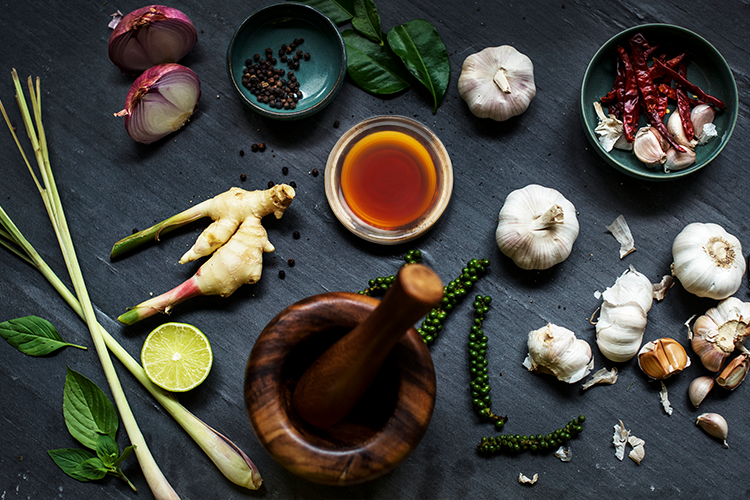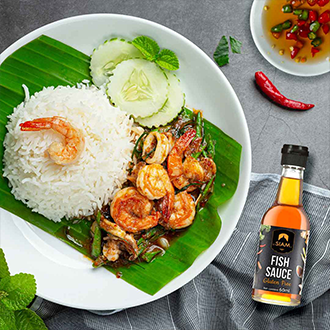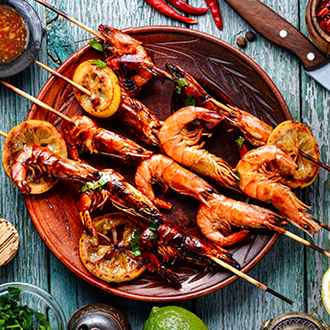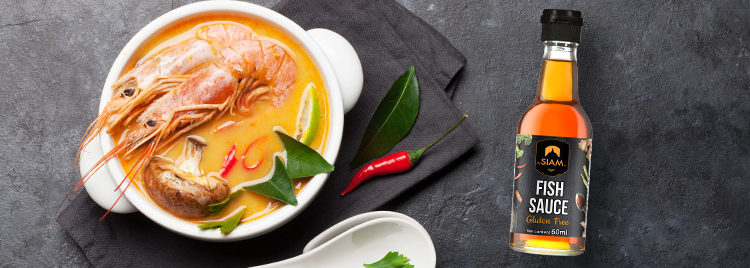My shopping cart
Your cart is currently empty.
Continue Shopping
The same way that salt is fundamental to western cuisines, fish sauce is a stable condiment in the Thai kitchen. Fish sauce, or Nam Pla in Thai, is made using salted anchovies that have been fermented for up to 2 years. The sauce is a central ingredient in cooking Thai food, lending its savory and umami flavor to many dishes, including Pad Thai, Curries, Tom Yam or Som Tam. You can learn more about how fish sauce made from our article ‘Fish Sauce, Essential Staple to Thai Cuisine’
Fish sauce is salty, savory, and earthy in flavor with notes of umami and sweet undertones. It has rich, translucent reddish-golden brown color liquid and gives off a distinct aroma, the same acrid fishy smell as cured anchovies. But good fish sauce adds a delicious dimension and savory umami element to food. Umami is a Japanese term that means “pleasant savory taste” also known as the fifth taste. Some foods that have a strong umami flavor are seafood, meats, aged cheeses, seaweeds, soy foods, mushrooms, tomatoes, kimchi, green tea, and fish sauce.

Fish sauce smells and tastes extremely pungent; however, it mellows during cooking. When combined with other ingredients, the sauce blends into a whole, supports other flavors and is unobstructive. In terms of health benefits, the sauce is high in protein and contains the amino acid that the body requires for growth and regeneration. It is also a good alternative to lower your sodium consumption. A recent study from the Institute of Food Technologists found that adding fish sauce as a partial salt-substitute to tomato sauce, coconut curry and chicken broth reduced the typical sodium chloride levels by 10 to 25 percent while retaining the same umami effect and perceived saltiness. However, the sauce itself is high in sodium, so it should be used with moderation.
If you are new to cooking with fish sauce, it is recommended to go in gently. Start with a few drops and keep tasting until you reach the right balance of flavor you like. No need to mix it with salts or other soy sauces, so you can learn how to work with it. Once you are familiar with using fish sauce, you can experiment it with other sauces. Fish sauce is not only versatile condiment for Thai food, but it can be a good use for cooking any other foods either oriental or western cuisines. Fish sauce can be used as a substitute for salt in many cases. It can add tremendous complexity to a dip, a marinade or a salad dressing. Here are some ideas to use the sauce to boost your food.

Fish sauce is salty and umami so it works great as a marinade. You can mix it with other seasonings like ground pepper, chopped garlic or soy sauces. In Thailand, a lot of the time they only use the fish sauce to marinade meat, a simple recipe but it tastes so good. You will be surprised how much flavor fish sauce can bring to the dish.
Fish sauce is great in stir-fried dishes. You can use only fish sauce to season the stir-fry or mix it with a bit of soy sauce and oyster sauce and you will get a wonderful umami stir-fry dish. Not sure what to cook tonight? Try our easy Stir-fried noodles recipe.

Fish sauce is a great condiment for soups, stews and curries. It amplifies the savory flavor and adds character to the western style soups or stews, like French onion Soup, or beef stew. For Thai curries, fish sauce is key to giving that savory umami element and balances out the spices in the dish.
A salad dressing with a touch of fish sauce is incredible. The sauce works with both Thai and western style salad dressing. Try adding 1-2 teaspoons of fish sauce in place of salt in vinaigrette dressing and you will get a surprisingly delicious result. Get your taste buds dancing with the zesty Thai salad dressing. It is usually salty, sour and spicy - a combination of fish sauce, lime juice, sugar, garlic, and chili. Try it on top of a meaty Thai-style Chicken Salad, and you will ask for more.
Fish sauce can also boost the flavor of your pasta sauce. Add a couple teaspoons to a Bolognese, and it enhances a beautiful savory flavor. It is also great in Marinara Sauce, an Alfredo Sauce, Puttanesca or Carbonara.
Try adding a few drops of fish sauce to your next Bloody Mary, in place of the more traditional Worcestershire sauce, and you will get a wonderful surprise.
Adding Panang curry paste and a tablespoon of fish sauce to your beef burger or meat loaf will turn your ordinary meal into something more exciting and tremendously delicious. You can try our Panang Burger recipe here.
Fish sauce can lend a rich, savory taste to mashed potato, just add some fish sauce in place of salt in the recipe.
You can add umami and more complex flavor to your pickles by adding 1-2 tablespoons in your favorite pickle recipe.

Fish sauce is a versatile condiment to create a variety of dips or dipping sauce. It can be used to make any dipping sauces for dumplings and potstickers, Taco Dip, Jalapeno Dip to Guacamole. Thai people use fish sauce as a base for many dips and sauces as well as, for example, Phrik Nam Pla (Fish sauce with chillies), Nam Jim Jeaw (Jaew sauce), or Nam Pla Wan (Thai Fruit Dip).
These days, most supermarkets sell fish sauce, you can check the Asian food section. You will also find a good selection of fish sauces at any Asian food markets or stores near you. For a more convenient way, you can order fish sauce from our online store which will deliver from Thailand directly to your door.

After being opened, fish sauce is going to last a long time at least a year and up to two. If you use it on regular basis (one or two times a week), you can store it in a cool, dry and dark place. It does not need to be refrigerated, but it will taste best and stay freshest if kept refrigerated. Store with the lid snapped shut and keep the cap screwed tight as exposure to air can turn the sauce darker in colour and evaporation can intensify its saltiness.